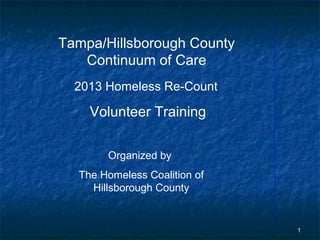
2013 Homeless Coalition Training Re-count
- 1. Tampa/Hillsborough County Continuum of Care 2013 Homeless Re-Count Volunteer Training Organized by The Homeless Coalition of Hillsborough County 1
- 2. WHAT IS THE HOMELESS POINT IN TIME COUNT? “ the number of people who are homeless at a single point in time, usually one day or one night” (Burt,1996). 2
- 3. Why are we doing a re-count? Special approval from the U.S. Department of Housing and Urban Development (HUD) has been received for our community to do the recount. The January homeless count produced an unrealistic decrease in the literally homeless population of Hillsborough county, showing a nearly 50% overall decrease. Several reasons have been identified as affecting the count data, including: 3
- 4. Re- Count Continued encampments that were known to exist just weeks prior to the January count were abandoned and/or completely gone; many of these areas also had newly posted no trespassing signs some individuals uncounted in January, refused to participate complete the survey, stating it was too long (the recount will utilize an abbreviated version of the survey form) front line service providers, when comparing data from January 2011 and January 2013 reported a slight decrease in demand for their services; but not anywhere near a 50% decrease. 4
- 5. SURVEY AREAS All of Hillsborough County • The County is divided into four districts • Each District will be divided into 4 regions • Each region will be defined by streets and landmarks • Each region will have a deployment site 5
- 6. HILLSBOROUGH COUNTY 6
- 7. LOCATIONS • Shelters • Streets • Service Providers • Parking Lots • Churches • Woods • Down Town • Camps • Libraries • Meal Sites • Day Labor Sites 7
- 8. METHODS • Physical Count • Through Interview • Data Analysis 8
- 12. PROCEDURES • Survey Teams • Deployment Centers • Guides (when numbers allow) • Count • Surveys • Command Center 12
- 13. LIMITATIONS The primary limitation of this method is under-counting, for it is nearly impossible to count ALL of the homeless people in a community in one day. 13
- 14. INTERVIEWER GUIDELINES • Informal, flexible, sensitive, and objective • Friendly conversational tone • Assurance of confidentiality • Follow survey wording • Explain questions • Personal safety 14
- 15. HUD DEFINITION A person is considered homeless only when he/she resides in one of the places described below: • sleeping in an emergency shelter; • sleeping in places not meant for human habitation, such as cars, parks, sidewalks, or abandoned or condemned buildings; • spending a short time (30 consecutive days or less) in a hospital or other institution, but ordinarily sleeping in the types of places mentioned above; • living in transitional/supportive housing but having come from streets or emergency shelters; • being evicted within a week from a private dwelling unit and having no subsequent residence identified and lacking the resources and support networks needed to obtain access to housing; or • being discharged from an institution and having no subsequent residence identified and lacking the resources and support networks needed to obtain access to housing. 15
- 16. Chronic Homeless (A) IN GENERAL.—The term `chronically homeless' means, with respect to an individual or family, that the individual or family— (i) is homeless and lives or resides in a place not meant for human habitation, a safe haven, or in an emergency shelter; (ii) has been homeless and living or residing in a place not meant for human habitation, a safe haven, or in an emergency shelter continuously for at least 1 year or on at least 4 separate occasions in the last 3 years; and 16
- 17. Chronic Homeless Cont (iii) has an adult head of household (or a minor head of household if no adult is present in the household) with a diagnosable substance use disorder, serious mental illness, developmental disability, post traumatic stress disorder, cognitive impairments resulting from a brain injury, or chronic physical illness or disability, including the co-occurrence of 2 or more of those conditions. (B) RULE OF CONSTRUCTION.—A person who currently lives or resides in an institutional care facility, including a jail, substance abuse or mental health treatment facility, hospital or other similar facility, and has resided there for fewer than 90 days shall be considered chronically homeless if such person met all of the requirements described in subparagraph (A) prior to entering that facility. 17
- 18. WHO NOT TO COUNT: 1. Anyone with a fixed regular night time residence including - Formerly homeless, residing in Section 8 SRO, Shelter Plus Care, Permanent Housing 2. Children or Youth residing in foster care or group homes. 18
- 19. DATE & TIME Volunteers will conduct the Survey on Tuesday – April 09, 2013 4:00 pm – 8:00 pm 19
- 20. HOW TO STAY INVOLVED Visit our web site www.homelessofhc.org For a list of Coalition Member Agencies And Contacts 20